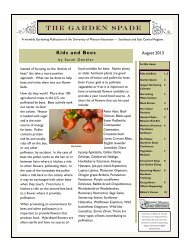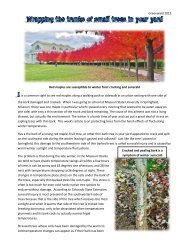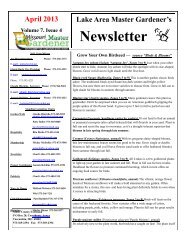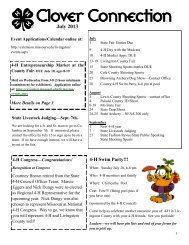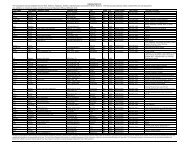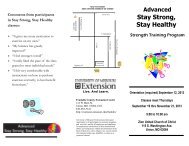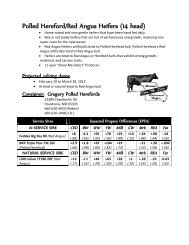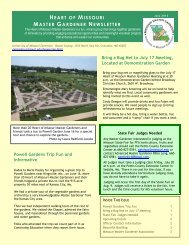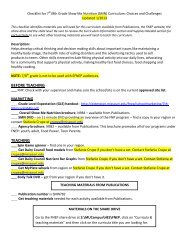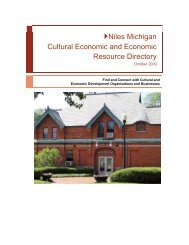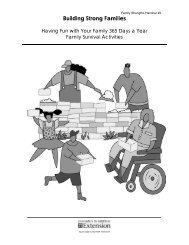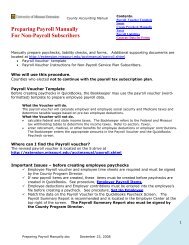Grazing System Design
Grazing System Design
Grazing System Design
You also want an ePaper? Increase the reach of your titles
YUMPU automatically turns print PDFs into web optimized ePapers that Google loves.
<strong>Design</strong> and Layout<br />
of<br />
<strong>Grazing</strong> <strong>System</strong>s<br />
Mark Green<br />
District Conservationist<br />
Natural Resources Conservation Service<br />
w/o
Components of the <strong>Grazing</strong> <strong>System</strong><br />
• Landscape<br />
• Forage<br />
• Livestock<br />
• Water<br />
• Fence
FLEXIBILITY
Guidelines for <strong>Grazing</strong><br />
<strong>System</strong> <strong>Design</strong><br />
Keep livestock<br />
within 800 feet of<br />
water<br />
– Improved grazing<br />
distribution<br />
– More uniform<br />
manure distribution<br />
– Increased water<br />
consumption .
Manure Distribution
Guidelines for <strong>Grazing</strong> <strong>System</strong> <strong>Design</strong><br />
Keep livestock within 800 ft of water<br />
Make paddocks as near to square as possible
Guidelines for <strong>Grazing</strong> <strong>System</strong> <strong>Design</strong><br />
What does “more nearly square” really<br />
mean?<br />
This is “more nearly<br />
square” !<br />
This is “less nearly<br />
square” !
Guidelines for <strong>Grazing</strong> <strong>System</strong> <strong>Design</strong><br />
• Make paddocks as near to square as possible<br />
• Less fence required
Guidelines for <strong>Grazing</strong> <strong>System</strong> <strong>Design</strong><br />
It takes less fence to enclose a square<br />
paddock of the same area.<br />
2640 ft<br />
3260<br />
ft<br />
If each paddock is 10 acres<br />
3380<br />
ft
Guidelines for <strong>Grazing</strong> <strong>System</strong><br />
<strong>Design</strong><br />
• Make paddocks as near to square as possible<br />
• Less fence required<br />
• Livestock are usually closer to water
Livestock will usually be closer to water in a<br />
square paddock<br />
Three options for dividing a 40 acre pasture
Guidelines for <strong>Grazing</strong> <strong>System</strong> <strong>Design</strong><br />
•Make paddocks as near to square as possible<br />
• Less fence required<br />
• Livestock are usually closer to water<br />
• More uniform grazing distribution
Figure 2. Impact of distance from water on temporal utilization<br />
rate in square and rectangular 10 acre paddocks.<br />
Temporal utilization rate (%)<br />
70<br />
60<br />
50<br />
40<br />
30<br />
20<br />
10<br />
0<br />
0 200 400 600 800 1000 1200 1400<br />
Distance to water (ft)<br />
Rectangular paddock<br />
Square paddock<br />
R-square=.82
Guidelines for <strong>Grazing</strong> <strong>System</strong> <strong>Design</strong><br />
Keep livestock within 800 ft of water<br />
Make paddocks as near to square as possible<br />
Follow contour lines of the landscape for<br />
paddock boundaries
Guidelines for <strong>Grazing</strong> <strong>System</strong> <strong>Design</strong><br />
Follow contour lines of the landscape for<br />
paddock boundaries<br />
• Soil drainage<br />
• Plant community<br />
• Slope and aspect<br />
• Erosion
<strong>Grazing</strong> <strong>System</strong> <strong>Design</strong><br />
Make primary<br />
subdivisions along<br />
contour lines or major<br />
soil changes<br />
Gentle<br />
slope<br />
Bottomland<br />
Steep<br />
slope
Guidelines for <strong>Grazing</strong> <strong>System</strong> <strong>Design</strong><br />
Keep livestock within 800 ft of water<br />
Make paddocks as near to square as possible<br />
Follow contour lines of the landscape for paddock<br />
boundaries<br />
Size paddocks by similar grazing capacity,<br />
not similar acres
Guidelines for <strong>Grazing</strong> <strong>System</strong><br />
<strong>Design</strong><br />
• Size paddocks of similar grazing capacity<br />
• Keep diet (availability) more consistent<br />
• Ease of rotation management<br />
• Can maintain desired rest period regardless of<br />
order pastures are grazed
Guidelines for <strong>Grazing</strong> <strong>System</strong> <strong>Design</strong><br />
Keep livestock within 800 ft of water<br />
Make paddocks as near to square as possible<br />
Follow contour lines of the landscape for paddock<br />
boundaries<br />
Make paddocks of similar grazing capacity,<br />
not similar size<br />
Use lanes for livestock movement
Animal Movement<br />
Goals<br />
Move livestock from any paddock to any<br />
other paddock without going through a<br />
third paddock<br />
Move animals from any paddock to<br />
working facilities without going through<br />
another paddock .
Lanes<br />
Plan lanes for livestock movement only<br />
• 15 - 20 % of manure is deposited in lanes<br />
• Cattle with water available in the paddock<br />
drink about 15% more water per day<br />
• Most erosion begins in vehicle tracks .
Lanes<br />
Width:<br />
– Machinery Movement<br />
through lanes<br />
– Make gates same<br />
width as lanes<br />
– If trail begins to erode,<br />
run hotwire down<br />
middle of trail .
Width<br />
Lanes<br />
Keep lanes on the contour when possible
Width<br />
Lanes<br />
Keep lanes on the contour when possible<br />
Avoid wet areas when possible
Width<br />
Lanes<br />
Keep lanes on the contour when possible<br />
Avoid wet areas when possible<br />
Use lanes for access to winter water
Guidelines for <strong>Grazing</strong> <strong>System</strong> <strong>Design</strong><br />
• Keep livestock within 800 feet of water<br />
• Make paddocks as near to square as possible<br />
• Follow landscape lines for paddock boundaries<br />
• Make paddocks of similar grazing capacity<br />
• Plan lanes for livestock movement only<br />
• Provide secure training facilities
Guidelines for <strong>Grazing</strong> <strong>System</strong> <strong>Design</strong><br />
• Provide secure training facilities<br />
• When exposing new animals to electric<br />
fencing they must be trained to respect<br />
psychological barriers<br />
• Area must be a physical barrier<br />
• Crowd animals within physical barrier with<br />
electric fencing<br />
• Use any material that will be used in the<br />
grazing system<br />
• Goal is to get as many animals educated<br />
(shocked) in as short of time as possible .
Guidelines for <strong>Grazing</strong> <strong>System</strong> <strong>Design</strong><br />
• Keep livestock within 800 feet of water<br />
• Make paddocks as near to square as possible<br />
• Follow landscape lines for paddock boundaries<br />
• Make paddocks of similar grazing capacity<br />
• Plan lanes for livestock movement only<br />
• Provide secure training facilities<br />
• Plan for adverse weather conditions
Guidelines for <strong>Grazing</strong> <strong>System</strong> <strong>Design</strong><br />
Plan for adverse weather conditions<br />
• Sacrifice paddock for extremely wet<br />
conditions.<br />
During drought?<br />
• Shelter from extreme cold/wet conditions<br />
• Shade – during extreme heat .
It depends!<br />
Do cattle need shade?<br />
– Are cattle grazing endophyte infected fescue?<br />
– Is the heat index over 100?<br />
– Have the cattle been selected for short hair<br />
coats and heat tolerance?<br />
– Is plenty of good quality water present?<br />
– What is the overall condition of the animals?<br />
– What are the animals accustomed to?.
• Cattle tend to congregate<br />
under shade even when<br />
they don’t need it<br />
– Time spent under<br />
shade reduces time<br />
spent grazing<br />
– Less grazing time<br />
results in less intake<br />
and reduced<br />
performance<br />
Shade
Shade<br />
• Shade is probably needed to help reduce<br />
heat stress any time the heat index is 100 or<br />
above<br />
Especially if livestock are grazing endophyte<br />
infected fescue
Cows<br />
Calves<br />
Effects of endophyte and shade<br />
Cow/calf<br />
E+S- E+S+ E-S- E-S+<br />
ADG -0.45 0.27 0.61 0.48<br />
∆BCS -0.5 -0.1 0.1 0.1<br />
∆HS 0.3 -0.1 -0.5 -0.3<br />
%Preg. 37.5 87.5 62.5 87.5<br />
ADG 1.70 1.87 1.99 2.13<br />
∆HS 1.1 0.8 -0.4 0.1
Shade can be<br />
– Portable,<br />
Shade<br />
Portable shade must be moved often to prevent<br />
nutrient displacement and maintain good ground<br />
cover<br />
– Natural shade within the paddocks, or<br />
– Shaded areas to move livestock to.<br />
– Some producers successfully graze shady<br />
paddocks during the day and move to<br />
paddocks with no shade at night
Shade<br />
Have some paddocks with shade available<br />
On hot, high humidity days, turn livestock into<br />
paddocks with shade<br />
On cooler or low humidity days, rotate livestock<br />
to paddocks without shade<br />
Cull animals with overheating problems.
ROTATION<br />
Move animals by watching the forage<br />
– NOT by order of paddock<br />
– NOT by the calendar.
Layout<br />
One wire<br />
Multi-Wire
Working<br />
Pens<br />
Gate Locations<br />
Layout
Gate Locations<br />
Layout
Layout<br />
Lanes vs. Pie Shape
• 140 acre pasture<br />
<strong>Grazing</strong> <strong>System</strong> <strong>Design</strong><br />
• Intermittent streams<br />
• One water source<br />
• Variable landscape<br />
• 2,000 ft maximum travel<br />
distance to water
• Fixed system<br />
<strong>Grazing</strong> <strong>System</strong> <strong>Design</strong><br />
(cont.)<br />
• Uses permanent fence and watering points<br />
• Flexible system<br />
• Uses portable fence and water facilities in a<br />
framework of permanent fence
• Fixed system<br />
<strong>Grazing</strong> <strong>System</strong> <strong>Design</strong><br />
(cont.)<br />
• Uses permanent fence and watering points
Fixed <strong>System</strong> <strong>Design</strong><br />
(cont.)<br />
The starting<br />
point for<br />
planned<br />
grazing<br />
management<br />
Can manage<br />
each field<br />
according to<br />
needs:<br />
fertility<br />
plant species<br />
growth/rest
Fixed <strong>System</strong> <strong>Design</strong><br />
(cont.)<br />
The beginning<br />
of management<br />
intensive<br />
grazing<br />
Can you<br />
identify<br />
potential<br />
problems?
Fixed <strong>System</strong> <strong>Design</strong><br />
(cont.)<br />
• 8 paddock system<br />
• Water available in<br />
every paddock<br />
• Alleyway for ease of<br />
livestock movement
• Fixed system<br />
Fixed <strong>System</strong> <strong>Design</strong><br />
(cont.)<br />
• Uses permanent fence and watering points<br />
Advantages:<br />
• Relatively low cost on<br />
large installations<br />
• Minimal daily labor<br />
• Low maintenance<br />
Disadvantages:<br />
• Relatively high cost on<br />
small operations<br />
• Limited management<br />
flexibility<br />
• Water mainly in lanes
• Flexible system<br />
<strong>Grazing</strong> <strong>System</strong> <strong>Design</strong><br />
(cont.)<br />
• Uses portable fence and water facilities in a<br />
framework of permanent fence
•Minimizes use of<br />
permanent fence<br />
Flexible <strong>System</strong> <strong>Design</strong><br />
•Make corridors as near<br />
to parallel as feasible<br />
•Keep fence spacing<br />
less than 660 feet<br />
(cont.)<br />
Permanent fence
Flexible <strong>System</strong> <strong>Design</strong><br />
(cont.)<br />
Above<br />
Ground<br />
Water<br />
Pipe<br />
Temporary<br />
fence<br />
Portable Water<br />
Tank
• Flexible system<br />
Flexible <strong>System</strong> <strong>Design</strong><br />
(cont.)<br />
• Uses portable fence and water facilities in a<br />
framework of permanent fence<br />
Advantages:<br />
• Maximum management<br />
flexibility<br />
• Lower initial capital cost<br />
• Works well on rented land<br />
Disadvantages:<br />
• More daily labor required<br />
• More maintenance<br />
• No Winter Water
Paddocks<br />
with<br />
Shade<br />
Fixed <strong>System</strong> <strong>Design</strong><br />
Hay<br />
& graze<br />
(cont.)<br />
Temporary<br />
fence<br />
for grazing<br />
Warm<br />
season<br />
grass<br />
Hay &<br />
graze<br />
• 9 paddock fixed<br />
system<br />
• Flexible paddock<br />
numbers in hayfields<br />
and/or warm season<br />
grass<br />
• Water available in<br />
every paddock<br />
• Alleyway for ease of<br />
livestock movement<br />
• Very flexible,<br />
workable system
Guidelines for <strong>Grazing</strong> <strong>System</strong> <strong>Design</strong><br />
Material cost<br />
per acre to<br />
subdivide to<br />
10 paddocks<br />
($/acre)<br />
The larger the grazing unit,<br />
the lower the cost/acre to subdivide<br />
50<br />
45<br />
40<br />
35<br />
30<br />
25<br />
20<br />
15<br />
10<br />
5<br />
0<br />
10 20 30 40 60 80 120 160 240 320 640<br />
Acres in the grazing unit
Summary<br />
There is no perfect system, only those that<br />
use good management principles to best<br />
fit available resources.<br />
The most flexible system will have some<br />
combination of permanent and portable<br />
fencing and water.



